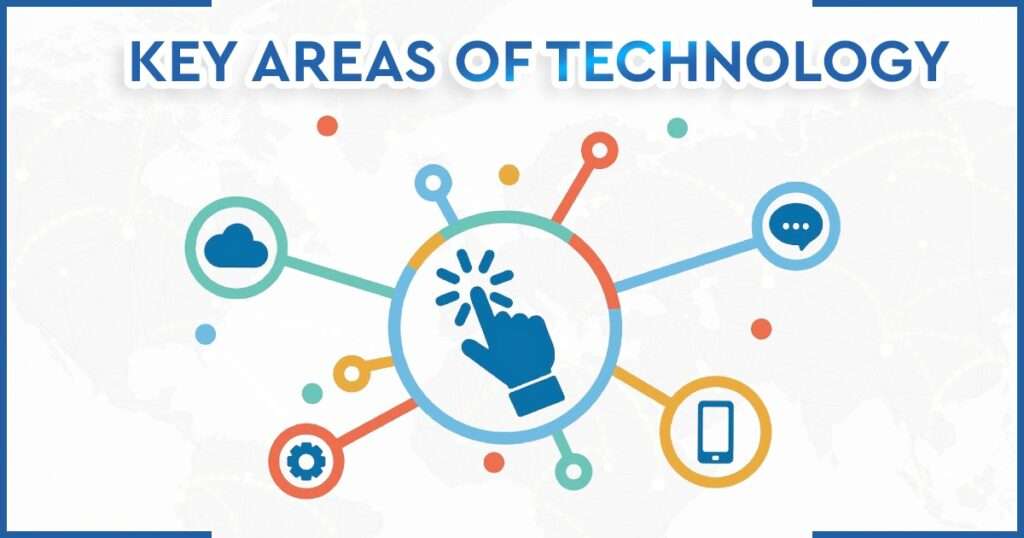Introduction:
Technology is used for scientific knowledge to create tools, systems and device that solve problem and improve human life. It includes wide range of field information technology, artificial intelligence, machine learning, biotechnology, engineering and more. it has evolved over centuries, from the invention of wheel and printing press to the development of internet and smart phones. Technology focus on invention to find advanced ways to make tasks easier, faster and more efficient. Technology transform every aspect of modern life, from how we communicate to other, work and travel and how we treat diseases.
Key Areas of Technology

1. Information Technology (IT)
Involves the use of computers, software, and networks for data processing and communication. IT has revolutionized industries, enabling global connectivity and automation.
2. Artificial Intelligence (AI) and Machine Learning (ML)
AI refers to the simulation of human intelligence in machines that perform tasks like problem-solving, decision-making, and learning.
ML is a subset of AI where machines improve their performance based on data.
3. Biotechnology
Uses living organisms and biological systems to develop new products and technologies, particularly in healthcare, agriculture, and food production.
4. Renewable Energy Technology
Focuses on developing clean, sustainable energy sources like solar, wind, and hydroelectric power to reduce reliance on fossil fuels.
5. Robotics and Automation
Involves designing machines that can perform tasks autonomously, improving efficiency in industries like manufacturing, healthcare, and even households.
HISTORY OF TECHNOLOGY
The history of technology is the history of invention of tool and techniques by human. It includes methods ranging from simple stone tools to the complex genetic engineering and information technology that has emerged since the 1980s.The word technology derived from Greek word “techne” mean art and craft. Gradually different things started to be invented but the main era of technology and invention came in the 18 century when industrial revolution started and machines got invented and various types of development and production started.
Advantages and disadvantages of Technology
1. Fast Communication
Technology has revolutionized communication, enabling people to connect instantly across vast distances through emails, messaging apps, social media, etc.
2. Enhanced education:
E-learning platforms, online courses and educational app can make learning more accessible and interesting.
3. Automation and productivity
AI and machine learning automate repetitive tasks, freeing up human resources for more strategic and creative work. This automation leads to increased productivity and efficiency within various business operations.
4. Cost and Time Efficiency
Technology acts as a powerful tool for businesses by performing tasks rapidly and accurately, leading to significant time and cost savings. For instance, a computer can process large amounts of data much faster than a human, allowing companies to accomplish more in less time and at a lower cost. By automating tasks and optimizing digital operations, technology solutions help reduce operational expenses.
5. Conducting Business Online
Running a business digitally enables companies to tap into global markets via online stores and virtual services. A robust online presence enhances customer engagement and opens up numerous opportunities for growth and expansion.
Disadvantages of Technology
1. Unemployment
Technological advancements have, consequently, resulted in automation replacing many traditional jobs, raising concerns about unemployment, particularly for roles involving repetitive tasks. For example, the use of robots in manufacturing and self-checkout machines in retail has significantly decreased the demand for human workers in these positions, thereby causing anxiety within the workforce.
2. Diminishing creativity
Technology has made people more dependent and less active, leading to a decline in creativity with many tasks now automated, individuals rely on technology for things they once did themselves for instance people used to solve simple math problem mentally, but now even basic calculations are done using device, often unnecessarily.
3. Privacy
Incorporating technology into our daily lives raises significant concerns about privacy. It is essential to ensure that personal information and data are well-protected. While many apps and tools implement privacy safeguards, these measures are often insufficient to fully protect against potential privacy risks.
CONCLUSION
Technology has become a fundamental part of modern life, shaping nearly every aspect of how we live, work, and interact. From the invention of early tools and machines to the advancements in artificial intelligence and biotechnology, technology continues to progress rapidly. It has transformed industries, boosted efficiency, and connected people globally. However, while this progress brings several challenges, such as job displacement due to automation and concerns over privacy, it is important to note that, on the other hand, the benefits of technology are immense. In fact, despite these drawbacks, technology not only offers solutions to global challenges but also significantly increases productivity and, furthermore, enhances the overall quality of life. As technology evolves, it will be crucial to strike a balance between innovation and managing its potential drawbacks for a sustainable future.
